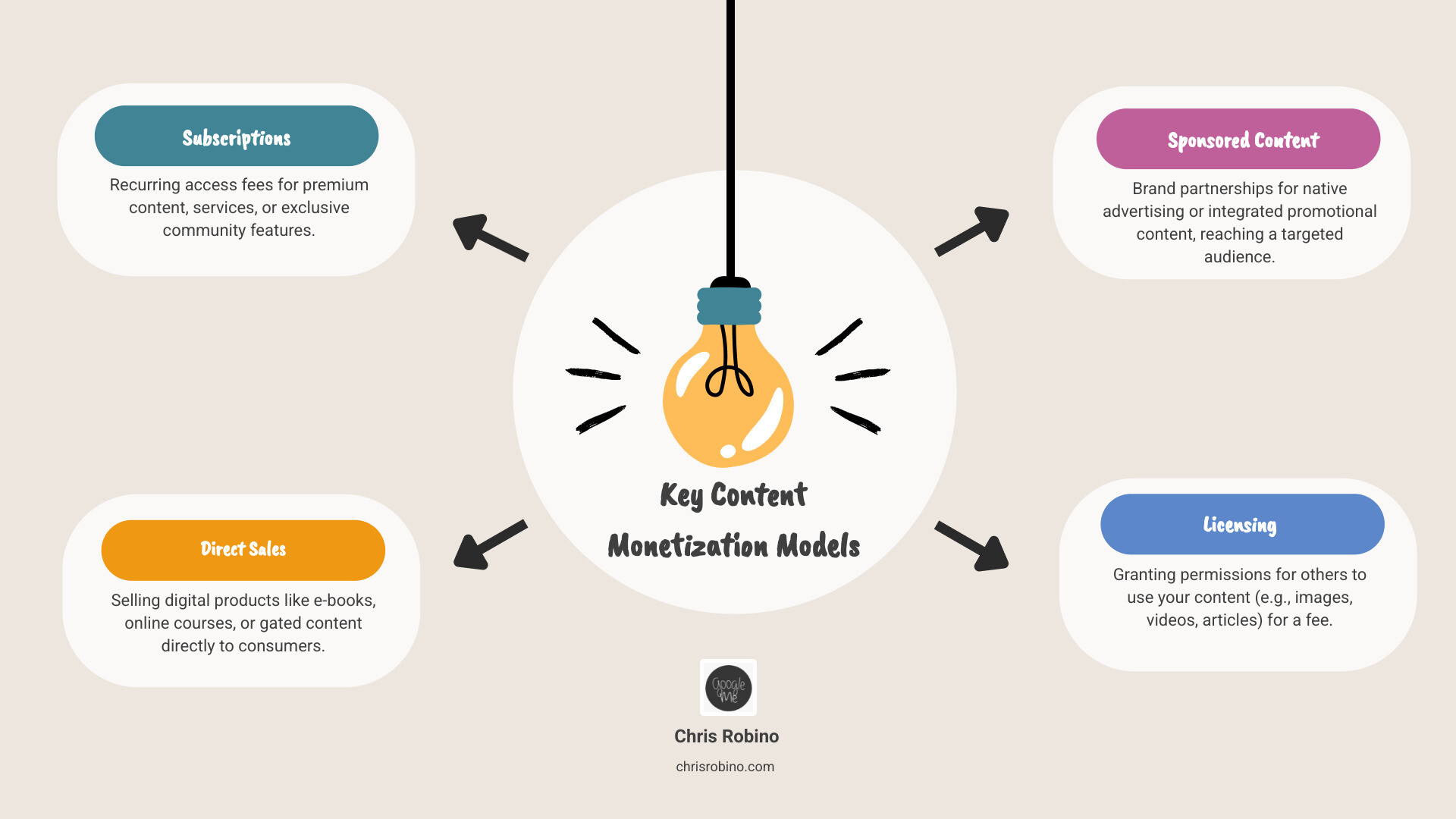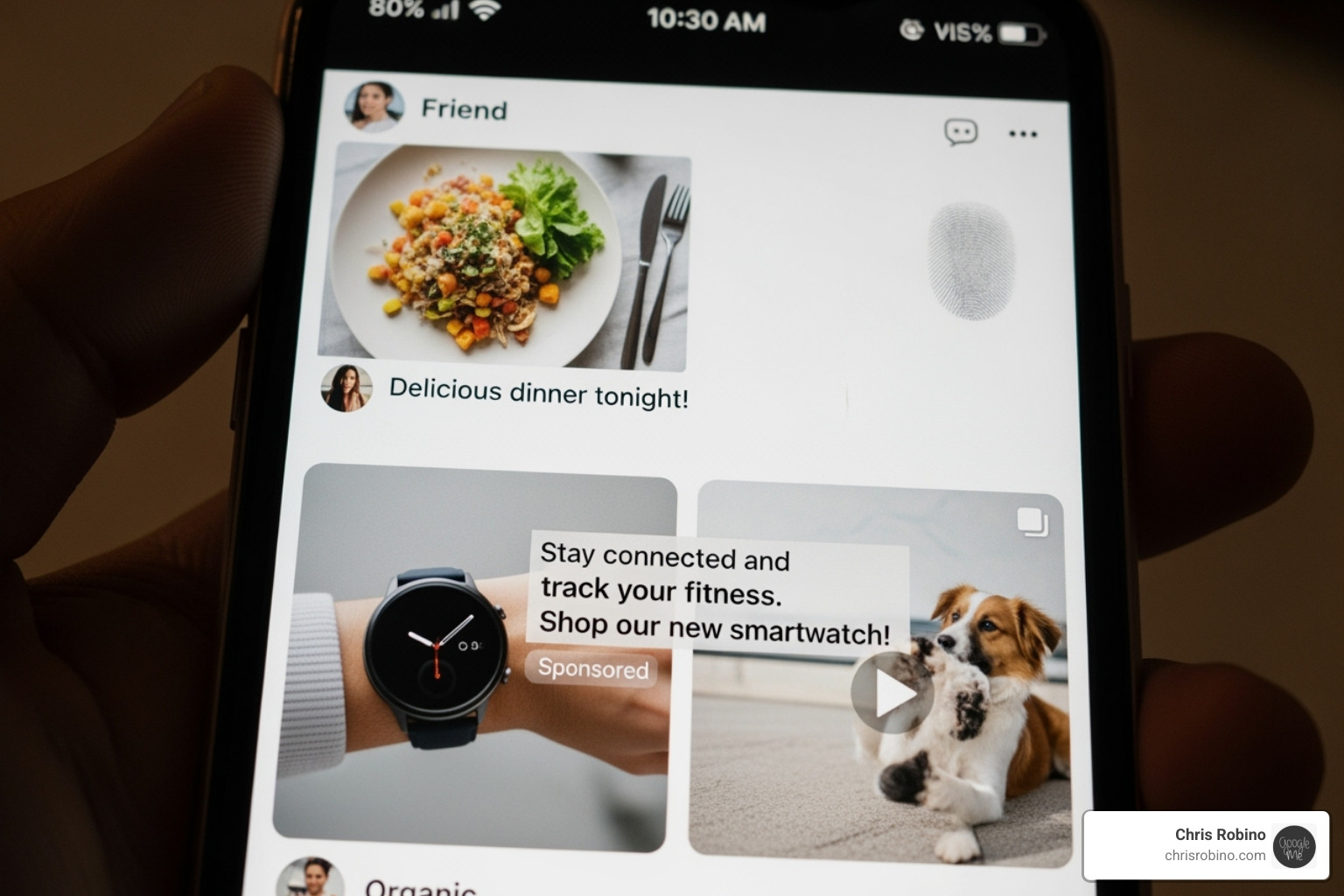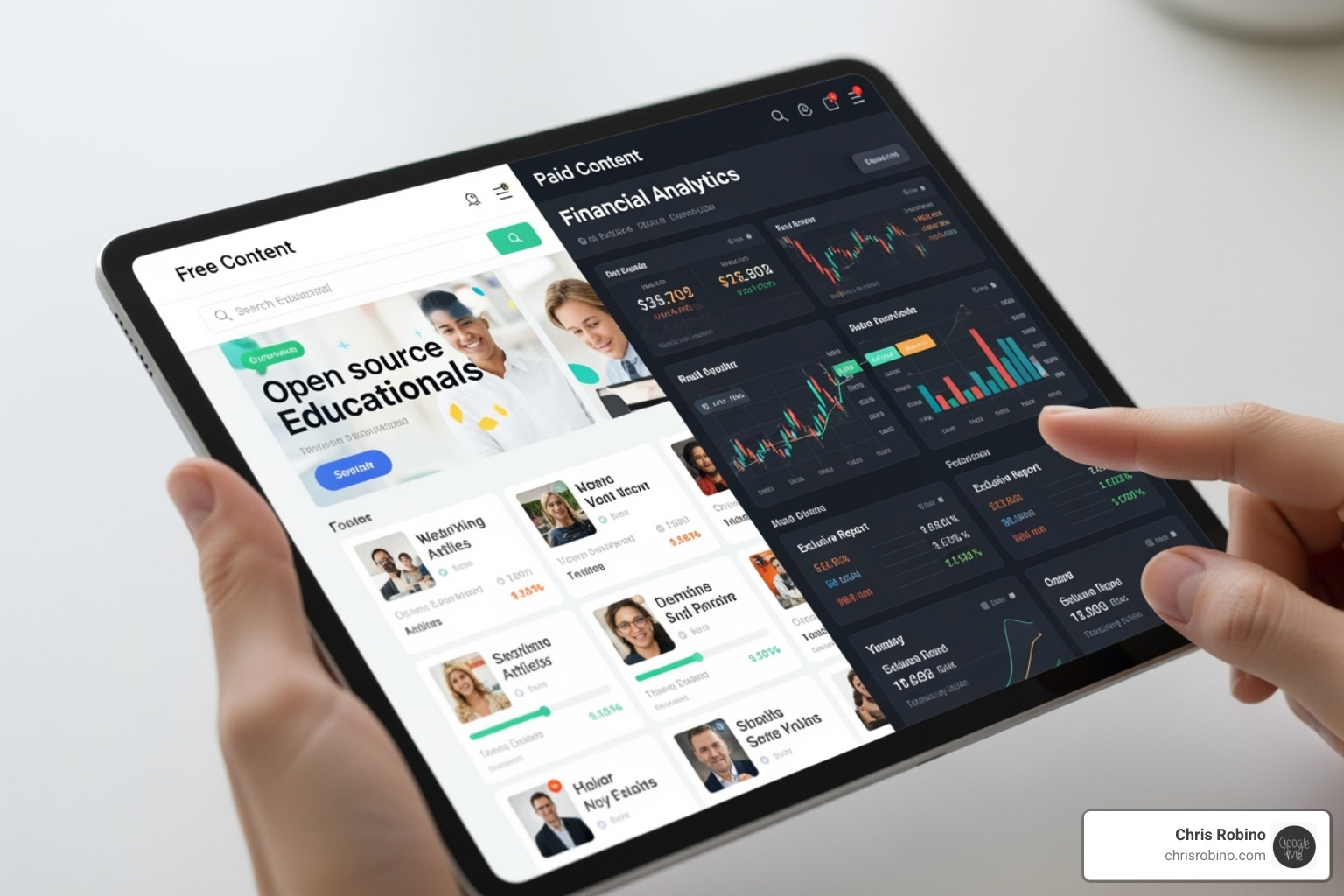Why Content Monetization is a Critical Growth Lever
Content monetization strategies are systematic approaches for generating revenue from digital content like blog posts, videos, and podcasts. Instead of being a cost center, your content can become a profit engine, opening new revenue streams and maximizing the value of assets you already create.
Quick Overview of Content Monetization Strategies:
- Direct Revenue: Subscriptions, memberships, premium content, digital products
- Indirect Revenue: Sponsored content, affiliate marketing, brand partnerships
- Hybrid Models: Content licensing, lead generation, community building
- Platform-Based: YouTube Partner Program, Patreon, newsletter platforms
The shift is clear: content is moving from a marketing expense to a standalone business model. The content marketing industry is projected to reach $107 billion by 2026, and numerous success stories with millions of paying subscribers prove the model’s power. Mastering this transition provides diversified income and stronger customer relationships.
I’m Chris Robino, a Digital Strategy Leader with over two decades of experience helping organizations turn their digital presence into revenue-generating assets. I specialize in developing and implementing sustainable, data-driven content monetization strategies that align business goals with audience value.

The Principal Content Monetization Strategies for Modern Businesses
Finding the right content monetization strategies involves choosing between three main pathways: direct revenue (your audience pays you), indirect revenue (brands pay for access to your audience), and hybrid models that blend both.
Direct Revenue: Selling Premium Content and Access
This approach involves charging your audience directly for high-value content. It’s a clear value exchange: create something worth paying for, and people will pay.

- Subscriptions and Memberships: Your audience pays a recurring fee for ongoing access to exclusive content or a community. The key is providing consistent value. Major publications have built empires with millions of subscribers using this model.
- Paywalls: These gate your best content. You can use a hard paywall (all content is paid), a soft paywall (a mix of free and premium), or a metered approach (a set number of free articles before payment is required).
- Digital Products: Package your expertise into one-time purchases like e-books or online courses. E-books serve a large market of digital readers, while online courses can generate significant passive income.
- Gated Content: Offer valuable resources like detailed guides in exchange for contact information. This builds your email list for future sales opportunities.
For businesses looking to create premium content, our B2B Thought Leadership Content Guide offers detailed strategies.
Indirect Revenue: Audience-Based Content Monetization Strategies
Instead of charging your audience, indirect strategies leverage their attention to attract payments from third parties.

- Sponsored Content and Brand Collaborations: Brands pay you to integrate their products into your content. Authenticity is crucial; choose partners that align with your audience’s interests.
- Native Advertising: Blend promotional messages seamlessly into your regular content so they feel like organic recommendations rather than disruptive ads.
- Affiliate Marketing: Earn commissions by promoting products you trust. Include referral links in your content, and you’ll earn a percentage of sales made through them.
- Selling Ad Space: Dedicate portions of your website or videos to display ads. Balance revenue with user experience, as 74% of people report being tired of social media ads.
Transparency is crucial with indirect monetization. The FTC guidelines for influencers require clear disclosure of paid partnerships. Being upfront builds trust.
Our guide on Consultant Content Marketing explores how to leverage content for indirect monetization.
Hybrid Models: Blending Strategies for Diversified Income
Smart creators combine direct and indirect strategies to create multiple, resilient income streams.
- Content Licensing: Grant other companies permission to republish your content for a fee.
- Lead Generation: Use free content like white papers to attract potential customers for your core services.
- Community Building: Cultivate a loyal community that is more likely to support you through memberships or direct purchases.
- Using Free Content to Promote Core Services: Offer valuable free content to build authority and guide users toward paid offerings like consulting.
- Repurposing Assets: Turn one blog post into a video, podcast, and infographic to maximize your content’s reach and monetization potential.
Our insights on Innovation in Media Companies can help you identify emerging opportunities.
Activating Your Monetization Plan: From Strategy to Revenue
Successful monetization is about creating valuable content that serves your audience, then guiding them toward a paid solution. It’s a process of building trust and demonstrating value.
How to Create High-Quality Content That Converts
Your content is the bridge between your audience’s problems and your solutions. Make it strong, and people will be willing to pay for the journey.
- Understand Your Audience: Know their pain points, questions, and goals. The better you understand them, the more effectively you can create content that serves them and converts.
- Deliver Real Value: Your content must solve a problem, whether it’s teaching a skill or providing entertainment. Quality always outperforms quantity, especially since platforms like YouTube reward content that keeps users engaged.
- Use Clear Calls-to-Action (CTAs): After providing value, tell your audience exactly what to do next, whether it’s downloading a guide or joining a membership.
- Invest in Your Skills and Tools: Better equipment, writing skills, and efficient creative approval workflows improve quality and build the trust necessary for monetization.
Explore AI-Driven Content Strategy to learn about leveraging AI to refine your content creation process.
Best Practices for Effective Content Monetization Strategies
Implementing your strategy requires balancing business needs with your audience’s experience.

- Balance Free vs. Paid Content: Use valuable free content as a gateway to your premium offerings. Give your audience a taste of the value you provide to encourage them to pay for more.
- Prioritize User Experience (UX): Don’t sacrifice long-term relationships for short-term revenue. Intrusive ads and constant sales pitches destroy trust.
- Combat Ad Fatigue: If you use ads, make them relevant and strategically placed. Focus on formats that improve, rather than interrupt, the user experience.
- Use Analytics to Monitor Performance: Track conversion rates, engagement, and revenue to understand what’s working. Data allows you to optimize your strategy effectively.
- Repurpose Content Strategically: Multiply your monetization opportunities by turning a single asset into multiple formats for different platforms and audiences.
Our Content Strategy Consulting services can help you develop and implement these best practices.
Getting Started and Measuring Success
Begin with what you have and build systematically.
- Assess Your Content: Inventory your existing assets (blogs, videos, etc.) to find hidden gems that are already performing well.
- Identify Opportunities: Use analytics to find your most engaging content. These are your low-hanging fruit for monetization, like adding affiliate links to a popular post or turning a blog series into a paid course.
- Set Measurable Goals: Define what success looks like. Are you aiming for a specific monthly recurring revenue, a number of course sales, or qualified leads?
- Monitor and Adapt: Continuously track performance against your goals using analytics. Be ready to adjust your strategy based on what the data tells you.
- Diversify Your Income: Combine multiple monetization methods (e.g., subscriptions, course sales, and affiliate income) to create stable, resilient revenue streams.
To learn more about how digital change can benefit your media business, explore our insights on digital change for media.
SEO Strategies for Large Companies: Maximizing Content Monetization
For large companies, sophisticated SEO is essential for maximizing content monetization strategies. Better search visibility means more traffic to your monetized content. Here are key SEO practices to focus on:
- Strategic Keyword Research: Focus on high-value keywords that align with your expertise and target users who are actively seeking solutions, making them prime candidates for conversion.
- Building Topical Authority: Develop topic clusters and pillar pages to create comprehensive resource hubs. This signals your authority to search engines, leading to higher rankings for a wide range of related terms.
- Smart Internal Linking: Guide users from high-ranking free content toward your premium offerings. Internal links create clear conversion paths and help search engines understand your site structure.
- Search Intent Optimization: Ensure your content directly answers the user’s query. High engagement from satisfying search intent boosts rankings and drives more qualified traffic.
- Structured Data Implementation: Use schema markup to enable rich snippets in search results. This makes your content stand out, increasing click-through rates to your monetized pages.
- Evergreen Content Refresh: Regularly update and repurpose your high-performing evergreen content to maintain its relevance and search authority, maximizing its long-term ROI.
- Advanced Analytics: Go beyond traffic and rankings. Track user engagement, conversion paths, and revenue per piece of content to identify what truly drives monetization.
- Integrated Channel Strategy: Combine SEO with paid campaigns to accelerate visibility for new monetized content. A hybrid approach maximizes reach and creates multiple customer touchpoints.
By aligning your SEO strategy with your monetization goals, you can drive the right traffic—users ready to convert—and create sustainable revenue streams that grow with your search visibility.
